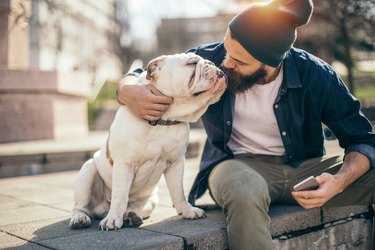The privilege of caring for a mother dog as she gets ready to birth her litter can be one of the most rewarding things to witness as a pet owner. Whether you've bred your dog on purpose or you've just found yourself the caretaker of an expectant mother, certain measures should be taken in order to give your dog and her puppies the best birth experience. If you are caring for a pregnant English bulldog, you'll want to be in close touch with your veterinarian throughout the process, as special measures may need to be taken at the time of delivery.

Video of the Day
Dog pregnancy timeline
Regardless of the breed, dogs are pregnant for about two months, or 62 to 64 days. Dogs have three trimesters, each of which lasts about 21 days.
Video of the Day
The English bulldog gestation period begins at about 15 to 18 days as the fertilized eggs travel to embed themselves in the lining of the uterine horn. A puppy's heartbeat can be detected within the first month of pregnancy, and by day 34, recognizable puppies have begun to form. Puppies will be ready to be delivered between days 62 and 64, at which point preparations should be made to ensure a safe and successful birth.
Pregnant English bulldog symptoms by trimester
Most dogs will display the same or similar dog pregnancy symptoms week by week. During the first few weeks, you likely won't notice anything different about your dog other than possible weight gain, as most dogs rarely display pregnancy symptoms so early. By week three or four, hormonal changes may make some dogs experience morning sickness.

If your dog is sick and vomiting in the mornings, it is suggested that you offer her smaller bland meals, like boiled chicken breast and white rice, more frequently throughout the day rather than all at once. Around 28 days, a veterinarian can locate the puppies either through an ultrasound or by feeling her belly, the latter of which must be done with care because mishandling can lead to birth defects or miscarriage.
As your dog enters her third trimester, her belly will become noticeably larger, and her nipples will take on a darker color and begin to protrude. Her breasts will become bigger as her due date approaches and may leak a small amount of milk from time to time.
Between weeks six and eight, you may be able to see your dog's puppies moving inside her as they prepare to be birthed. A veterinarian will then assess whether her birth canal is large enough to pass the litter. If it isn't, a C-section procedure should be scheduled to assist with the birth.
Some dogs may not want to eat as labor begins. A good sign that puppies are on their way is when the dog's rectal temperature drops below 99 degrees Fahrenheit for two consecutive readings. This signals that puppies should arrive within the next 36 hours but more likely 12 to 24 hours.

Pregnant English bulldog care
Caring for a pregnant bulldog is a big responsibility and one that should be taken on with insight, planning, and preparation. The first thing you'll want to do is consult with your veterinarian to discuss the proper diet for your specific dog, which will ensure a healthy mother and puppies throughout the pregnancy. Adequate exercise is another important measure to take, which may help prepare her physically for the trauma that's about to come.
Like other dogs, a pregnant English bulldog will sometimes become restless and scratch at her surroundings, preparing a nest for her babies. To help her along, you may want to provide blankets or towels on which she can rest.
At least two weeks prior to your dog's due date, create a denlike space in a quiet part of the house where she will whelp her puppies. Common whelping boxes include kiddie pools lined with sheets or towels or a large cardboard box lined and padded with washable blankets. Make sure that your whelping box is secure enough that the puppies cannot accidentally roll out but that your bulldog can easily get in and out of it.